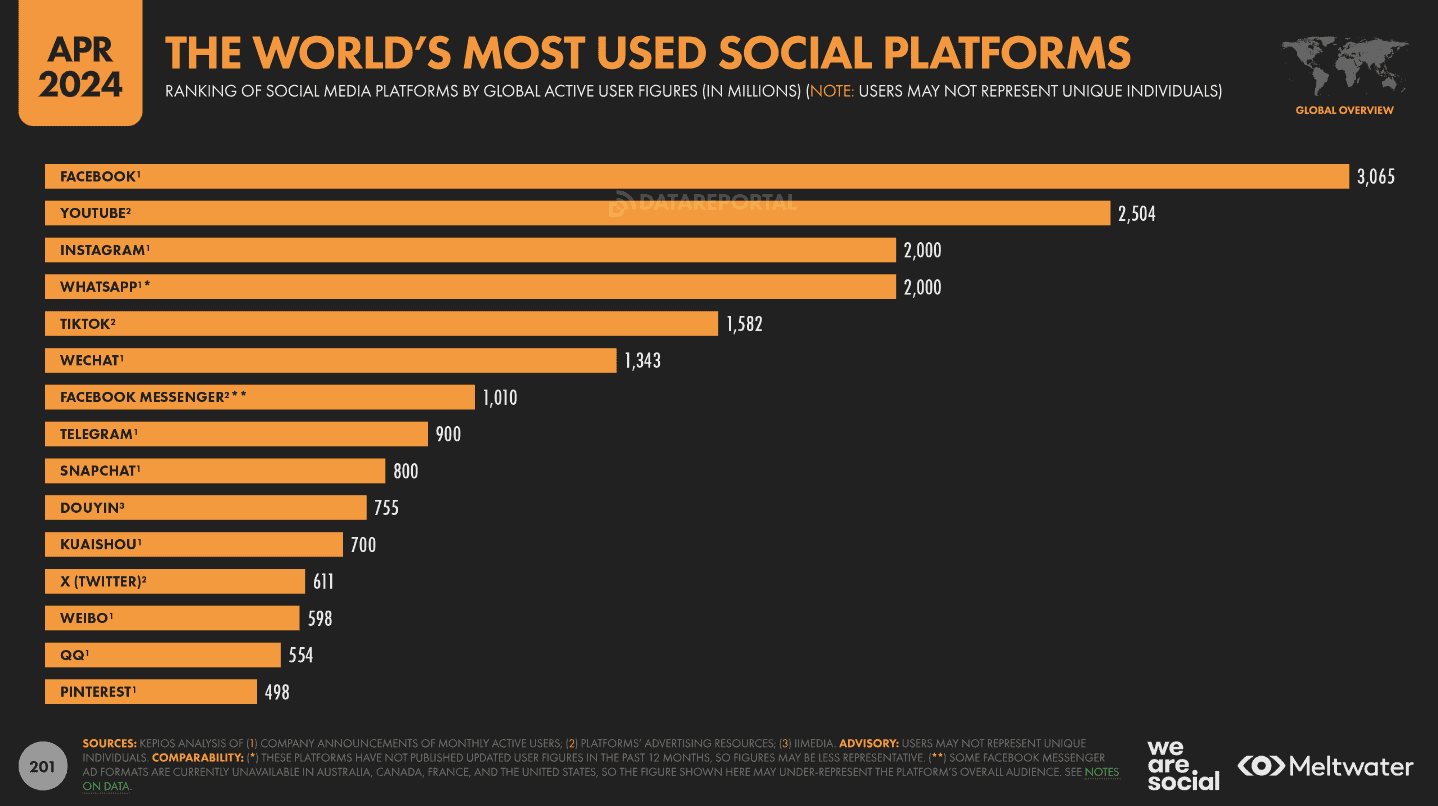Social media is a profitable goldmine for marketers with the right tools. And here’s why:
- Nearly 62% of the global population is active on at least one social media platform. This makes up 93% of people using the internet in 2024 and a large percentage of your business target audience.
- About 34% of social media users say they use social media to read news stories and find content, whether directly posted on their profiles or shared from their websites. Another 26% say they use it to find products to purchase.
However, the results you get are just as good as how much you show up on your target audience’s radar. And thanks (No thanks) to the increasing adoption of social media for marketing by new businesses, it means there’s a growing competition to achieve visibility.
That’s where social media SEO comes in.
In this article, we will discuss social media SEO, how it affects your social media profile and website, and 9 strategies to scale your SEO in 2024.
What Is Social Media SEO?
Some say social media SEO is primarily about appearing on social media platforms for certain prompts, while others believe it’s all about optimizing existing social accounts for direct or indirect traffic generation to your website.
Brandy Hastings, SEO Strategist at SmartSites, believes both definitions are correct when combined.
Brandy says, “The line between social media and traditional SEO is gradually blurring. Social platforms like Facebook and LinkedIn now have search bars that replicate search engine functions by allowing users to look up certain keywords and find brands via their posts or accounts. So, that’s social media SEO in one sense.”
“But optimizing your social media profile for visibility on people’s feeds also exposes your website link whether through social posts or website address in contact sections, and it additionally boosts branded Google/Bing search. That’s social media SEO in another sense. If you combine both instances, you will see they are not mutually exclusive”, he continues.
So, based on this view, what is Social Media SEO?
Social media SEO is a marketing strategy that involves optimizing your social media profiles and content for visibility with the aim of boosting lead generation, conversions, and sales either on social platforms or on your website, or both.
Does Social Media Impact Website SEO?
The answer is NO!
Marketers often argue that social signals are part of Google’s ranking factors for websites. Let’s break the whole Saga down.
According to Google, organic buzz and shareability of content essentially improve your website’s reputation.
“Creating compelling and useful content will likely influence your website more than any of the other factors discussed here. Users know good content when they see it and will likely want to direct other users to it. This could be through blog posts, social media services, email, forums, or other means.”
Organic or word-of-mouth buzz is what helps build your site’s reputation with both users and Google, and it rarely comes without quality content.” – SEO starters guide by Google.
In fact, Google later introduced a social analytics tool to help marketers gauge their traffic sources while tying them to overall revenue generation and eventual conversions.
The giant search engine also agrees to use social media profiles, among other profiles, to gather adequate information and present an accurate image of a local business to potential customers.
All these keys led to the assumption that social signals affect a website’s SEO. But John Mueller, a search advocate at Google, debunked that fact in 2015 and said social signals do not directly influence organic rankings.
He also clarified in 2016 and 2021, saying “Likes” alongside “shares, views, etc.” on social media are not used as a ranking factor. Gary Illyes, Chief of Sunshine and Happiness at Google, backed this up, saying social media helps you market your content instead of helping you rank better.
So, we can all agree social media SEO does not equate to using social media to directly improve your website SEO. However, it can offer you the benefits of SEO—which is traffic and lead generation.
- Traffic generation: When you create a blog post on your website and share an excerpt on social media, people engage with it and often follow through to your website to read the content fully. This happens often on platforms like Facebook, which has over 3 billion active users, and LinkedIn, which has over 1 billion users.
- Branded Search: Social media exposes your business to millions of people, or say billions, for the likes of Alibaba and Amazon. This increases people’s awareness of your brand and positions you as a go-to solution provider.When potential customers later need your service, they can easily go to their Google or Bing search box and input your brand name directly. According to Statista, 42% of online searches are branded searches—which is a lot.
- Generate Content Insights: “One of the best places to follow trends and know what’s creating a buzz in the market is social media. You get to see which topics are on your target audiences’ lips. Places like Qoura also help you find what questions or queries your potential customers need answers to”, says John Baek, Founder of JSB Digital Works.By leveraging this wealth of information, you can optimize your SEO and content marketing strategy to create customer-centric and solution-providing blog posts, not generic content that’s strewn all over the internet.

9 Social Media Strategies to Boost SEO
An efficient social media strategy is essential to boosting your visibility on social media and improving website traffic generation. Let’s quickly explore the 9 proven and actionable strategies below.
Optimize Your Social Media Profiles
Similar to a website’s meta title and description, your social media profiles have social titles or business names, descriptions or bio, and contact sections. Some allow you to add past experience, work history, recommendations, and educational certificates.
A common mistake is to randomly fill these spaces with afterthought terms. These terms not only portray your business to social media followers, but social media algorithms use them as valuable information, determining your business’s relevance and recommending it to other users on search.
To effectively optimize this forefront,
- Use a keyword research tool like SEMrush to find relevant keywords for your brand. Focus on unique and long-tail keywords.
- Ensure these keywords align with current demand in your industry.
- Insert them strategically when crafting your display name, social description, and other sections.
- Avoid overstuffing any section with keywords. There’s no proof it improves ranking.
- Fully describe what your business offers in the description section. It’ll help users find what they need faster.
- In the Bio, description, and contact section, add links to your website. This will help direct traffic to your pages.
- Add social badges to improve your account’s credibility and search rankings.
Use Keywords in Social Media Content
Another component of social SEO that works like website SEO is content. For normal web blogs, you are expected to optimize with essential keywords you want to rank for on search engines.
Likewise, the content you post on social media platforms needs to be optimized so that it appears on your target audience’s feeds and when they search for your brand-related or demand keywords.
For efficiency,
- Look for high-demand keywords related to your brand and content. Focus on demand generation terms.
- Sprinkle them across your content and ensure they flow to give it an overall value.
- Use keywords as hashtags after each content. That’s non-intrusive and also aids virality.
Share Quality Content
While the whole saga about keywords is true, as we’ve previously explained, nothing beats good content. Social media search algorithms work like search engine algorithms; filtering good content and recommending them to users based on how valuable it is.
Brooke Webber, Head of Marketing at Ninja Patches, says, “Besides making you a favorite of social search algorithms, your social followers want good content, not some generic content that lacks experience and value. So, even if they come across an irrelevant post, what determines engagement—likes, shares, clicking to visit your website, etc.—is how good the content is.”
To make quality content,
- Use Google Trends, Qoura, social analytics tools, and search dropdowns to find trending social topics in your industry.
- Write on these topics with as much value and practical experience as possible.
- If you have a post that expands the topic on your website, provide a link for users to access it.
- Sometimes, show, don’t tell. Use carousels and videos to convey your message succinctly.
- Use bulleting and small sections for textual content. No one likes cramped data, no matter how valuable it is.
- Write attention-attracting post headers that will pique your audience’s interest even before they click to read.
Engage with Followers Regularly
Showing your users they are a valuable and “visible” part of your community as well is another approach to improve your social profile visibility and also increase traffic to your website.
This can be done in two ways:
- Passive engagement: Respond to people’s comments on your social posts, like, and tag their opinions.
- Active engagement: Occasionally check out your followers’ posts and engage accordingly. Provide valuable comments that don’t come across as formal—loosening up won’t hurt.
Consistency is paramount, and that’s why it’s important to delegate your social media management tasks to someone who can devote their entire time to them.
According to Cache Merrill, CEO and Founder of Zibtek, “Once users feel valued and engaged, they ultimately reciprocate with equal engagement. This, in turn, boosts your social visibility and traffic to your website if other factors are properly put in place.”
Leverage User-Generated Content
User-generated content (UGC) is unique and original content—posts, comments, videos, testimonials, and reviews—created by your customers, social followers, and any other group that benefits from your product or services.
Interestingly, UGC influences the buying decision of 79% of buyers, with millennials saying they trust such content 50% more than brand-generated content. This is not surprising, given that we tend to trust the practical experience of other people, like our friends and families, about a product.
To properly leverage UGC for social and website SEO:
- Launch and encourage UGC campaigns on your social media platforms. Provide hashtags to unify the campaign and create a buzz around your brand.
- Engage content from the campaign results—like, share, and comment wherever necessary.
- Extract UGC samples to create blog posts and share excerpts on your social platforms. It serves as a way to redirect traffic from social media to your website.
- Use content as social proofs on your account and brand proofs on your website. This will stabilize prospects’ trust in your products and services.
Utilize Social Sharing Buttons
Since social media SEO focuses on both your website and social media account, you have to provide a two-way link between them. The first one is by placing your website link in the social description as we previously discussed.
The second step is to add social sharing buttons to your website. See what SEMrush did below:

When adding social sharing buttons, consider placing them at the start and end of your posts for easy access. Making them scrollable on the sidebar works as well, but you should avoid intrusive bars.
Cross-promote on Different Platforms
The concept of omnichannel marketing also applies to social media on a more granular level. While Facebook holds close to 3 billion monthly active users, that doesn’t mean you can’t milk traffic from other platforms with smaller users like LinkedIn.
Most importantly, each platform is tailored to accommodate specific business needs. For instance, LinkedIn is best for B2B SaaS professionals, whereas fashion and beauty brands will find more demand on TikTok or Instagram.
Despite this specificity, adopting multiple channels to promote your brand helps you build a vast social presence and authority. If each platform provides a no-follow link to your website, whether through posts or profiles, it’ll also contribute to the overall traffic generated.
Collaborate with Influencers
“Influencers are individuals with a large fan base, a robust online presence, and often a controversial speaker of diverse sensational topics on social media. Since they know how to create a buzz around any topic, it’s very easy to use them to improve your social media profile visibility”, says Sergey Taver, Marketing Manager at Precision Watches.
Also, 44% of GenZs have purchased a product or service from a brand because they were recommended by an influencer. So, this approach provides both traffic and sales for your brand with a far-reaching—even as much as directing people to visit your website.
When choosing an influencer to partner with:
- Focus on your loyal customers with a sizable follower base first. They are your primary brand advocates.
- Identify influencers relevant to your brand or industry. Contact your preferred choice and discuss how it should proceed.
- One influencer at a time. Assess the quality of their followers and if they have needs that align with your brand offerings. Also, evaluate past influencer records with other brands.
Track and Analyze Social Media Metrics
It’s not just enough to implement all the strategies above; you need to measure their effectiveness over a period. And that’s only possible by analyzing certain metrics such as engagement rate, reach, shares, click-throughs, conversion rates, etc.
For example, to maximize your results, it’s essential to schedule Instagram posts strategically, ensuring that your content reaches your audience at optimal times.
You should also track metrics like referral traffic from social media and other sources. Social analytics tools like Google Analytics and Hootsuite provide more accurate metrics to use in evaluating your social media SEO and impact on website traffic.
“Look for loopholes or opportunities to leverage from each assessment, and improve your existing strategies with time. It’s also important to allow enough time to see good results before flagging off a strategy”, Jeffrey Zhou, CEO and Founder of Fig Loans, adds.
Wrapping Up Social Media Strategies to Boost SEO
Social media opens up a lot of success possibilities for your business through proper optimization. And that’s why it’s essential to implement multiple strategies to get the best results. For a start, optimize your social media profiles and content with appropriate traffic-generating keywords.
Share quality content if you want to improve engagement, and also actively stay in touch with your followers. Leverage user-generated content to build buzz online and utilize social sharing buttons on your website.
Cross-promote on different platforms, collaborate with influencers for more reach, and track performance to improve your social media SEO strategies.

